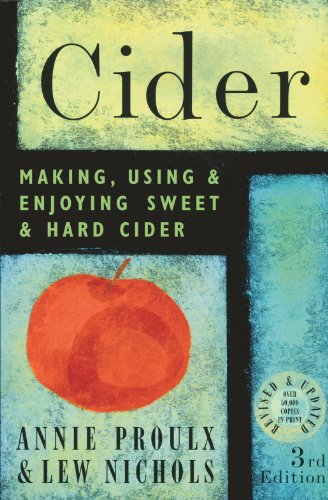
Author: Nichols, Lew
Price: $9.90
Category:Cooking by Ingredient
Publication Date:2003-09-08T00:00:01Z
Pages:224
Binding:Paperback
ISBN:10:1580175201
ISBN:13:9781580175203
The Pilgrims drank cider as they sailed to America aboard the Mayflower. John Adams had a tankard of cider every morning at breakfast. After a long day on safari, Ernest Hemingway liked to kick back beside the campfire with a glass of cider. And Robert Frost saluted his favorite beverage with a poem titled ?In A Glass of Cider.? Neck and neck with brewing beer at home is the resurgence of making cider. Whether sweet, hard, blended, or sparkling, trend watchers say cider, once the preferred beverage of early America, could very well become the drink of the future. (Hard cider is the fastest growing segment of the beverage industry.) Keeping pace with the commercial cider producers are small-scale and individual cider makers who have discovered how easy it is to make their own. After all, the only ingredient you need is an apple. In this updated edition of Cider, Annie Proulx and Lew Nichols take you step-by-step through the process that renders fruit into a refreshing drink. In addition to learning about the equipment you?ll need to make a glorious cider, Proulx and Nichols also discuss the pros and cons of various types of apple presses ? from traditional heavy grinders to sleek hydraulic presses. You?ll also learn about the glass bottles vs. wooden barrels debate; how to filter, fine, and rack your cider; and where and how to store it. Proulx and Nichols provide detailed recipes for making six types of cider: still, sparkling, champagne, barrel, French, and flavored, with advice on which apples to use to achieve a tart, aromatic, astringent, or neutral quality in your cider. In fact, this book is brimming with expert advice on cidermaking. If you want to plant your own apple orchard, this book has an entire chapter that lists which cultivars of apples thrive in which parts of the United States and Canada, along with each cultivar?s characteristics and when it is ready for harvesting. Another chapter explains how to care for an orchard, from improving the soil to pruning and thinning the trees to fighting off pests and wildlife. Once a cidermaker has learned how to make excellent cider, he or she is likely to look for further fields t o explore. With that in mind, the authors include a chapter on making cider vinegars and brandy and using cider in cooking. Finally, Proulx and Nichols walk you through the latest federal regulations covering the production and sale of homemade cider in the United States and Canada, and they familiarize you with the kind of impact state and provincial laws can make.The clear, simple language, numerous illustrations, and detailed step-by-step directions make it easy for even novices to become skilled cidermakers. This revised edition of the classic handbook is a complete guide for anyone who wants to discover the pleasure of making ? and drinking ? fresh cider.


![Essential Ottolenghi [Special Edition, Two-Book Boxed Set]: Plenty More and Ottolenghi Simple](https://kitaab.xyz/wp-content/uploads/2024/10/big1984858335.jpg)



